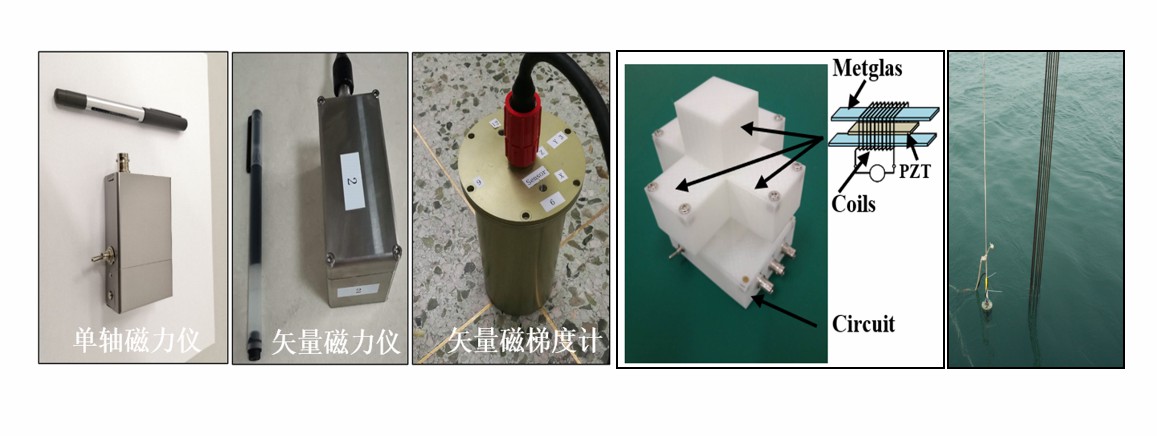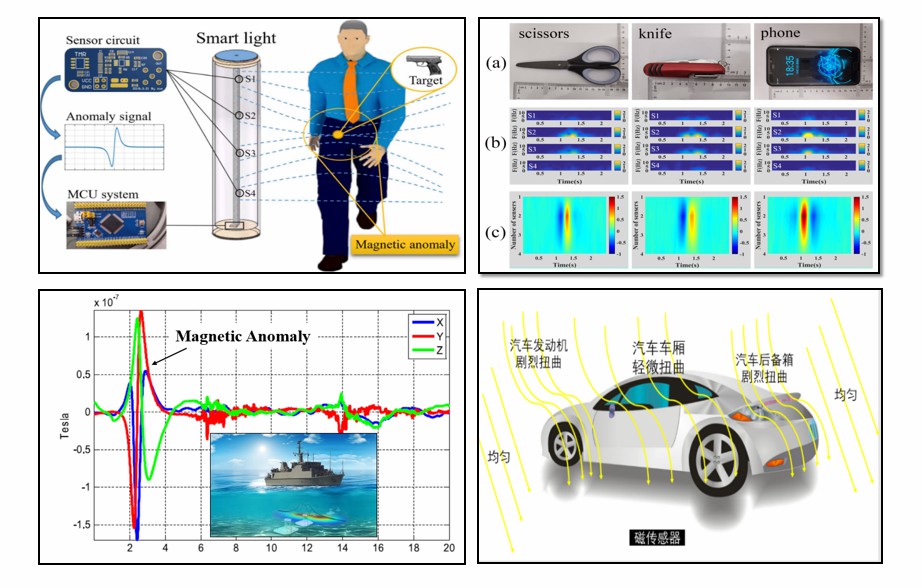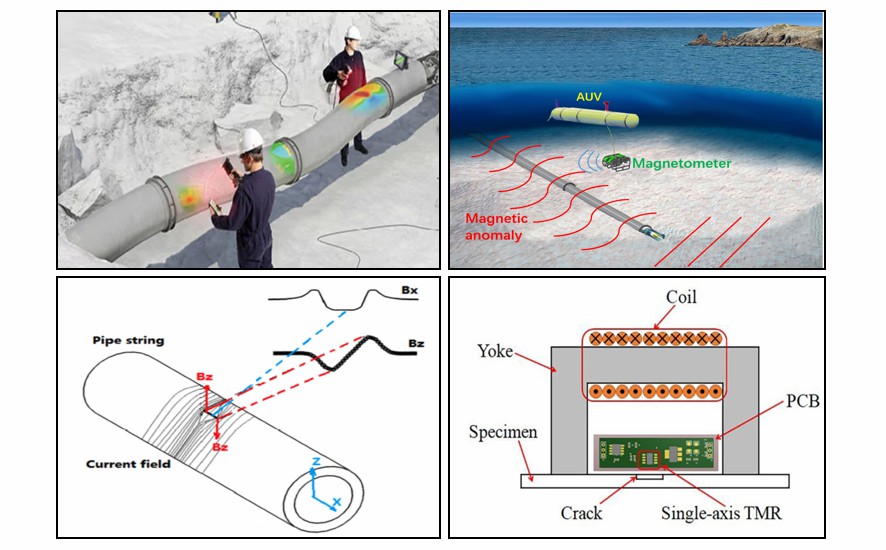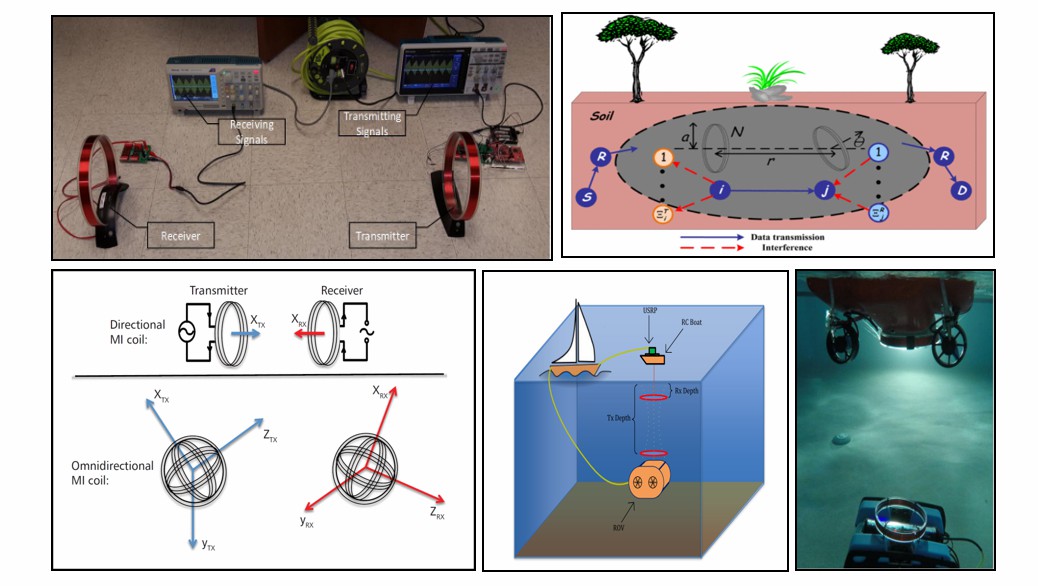
Research Topic
Vector Magnetometer
矢量磁力仪

Detection technology utilizing local magnetic anomalies of ferromagnetic objects has be come an important trend in target detection. Detection of a magnetic dipole target usually includes determinations of its position and magnetic moment, which contains six scalar unknowns. Localization and magnetic moment estimation is conventionally realized by measuring the total magnetic intensity or magnetic field vectors, using magnetometers installed on a mobile platform. Vector magnetometers are largely used in practices, which measure the three components of the anomaly magnetic field. Either the three components, or the total field (the modulus value of the three components), or the tensor gradients, or a combination of them can be used to construct an optimization algorithm for inversion of the six quantities. We have explored TMR (Tunneling Magneto-resistive) and ME (Magnetoelectric) sensors as a viable one in extremely sensitive vector magnetometer and gradiometer.
Magnetic Anomaly Detection
磁异常探测

As a result of magnetization by the Earth’s magnetic field, a metallic material can create distortions in the local geomagnetic field along each of its three orthogonal directions. Magnetic anomaly detection (MAD) is the use of such phenomenon by magnetic sensors because of the passage of a metallic material nearby a stationary sensor or when a sensor is mounted on a moving platform to sense a stationary target. The MAD method has been proven to work aboard in traffic surveillance, vehicle parking , sea mine hunting, security checking, unexploded ordnance discrimination, subsea cable and underwater vehicle detection .
Electromagnetic Non-Destructive Test
电磁无损探伤

Eddy current (EC) testing is one of the most known and widely used non-destructive test (NDT) methods of conducting materials. EC testing represents a non-destructive electromagnetic inspection technology capable of both surface and subsurface flaws detection and sizing of conductive metals. Similar to the EC technique, the ACFM (alternating current field measurement) method relies on current-carrying wires to introduce a thin-skin eddy current in the work-piece. The ACFM technique employs a bi-axial magnetic sensor to gauge the magnetic field perturbation caused by a crack that can be used in a non-contact manner with no threat to operators. Also, the ACFM method does not require coating removal because it is relatively immune to the lift-off effect, clearly demonstrating its merit as a very NDT approach.
Magnetic Communication
磁通信

Magnetic communication is also called magnetic induction communication which is being widely used for near-field communication (NFC), such as underground and underwater communication. The classical electromagnetic waves do not work well in these harsh environments, and the acoustic communication underwater faces many problems, such as high propagation delays, very low data rates, and highly environment-dependent channel behavior. While the magnetic induction (MI) technique is a promising alternative wireless communication solution to deal with these situation. The MI technique utilizes the near magnetic field of coils to propagate the information, thus, achieving constant channel conditions via small size of coils. The negligible propagation delay, predictable constant channel response, sufficiently large communication range and high data rate make the MI communication suitable for NFC in harsh environments.
Research Project
Ongoing Project
- 国家“万人计划”青年拔尖人才项目,006170130620,2025/01-2027/12
- JKW173基础加强重大项目子任务,2021-JCJQ-DA****-***-**,2022/05-2027/05
- 面向****智能化航磁探测的关键技术研究,3072025YY0501,2025/01-2026/12
- 贵州省威宁县海拉镇*****航磁测量,KY10500250068,2025/01-2026/12
- 基于航空电磁的*****探测与状态估计方法研究,KY61700240234,2024/09-2026/08
- **行动专项,KY61700240180,2024/01-2025/12
- 山东省泰山学者青年项目,79018005,2023/1-2025/12
- 科技部重点研发计划,2022YFC3104000,2022/12 - 2025/11
- 科技部重点研发计划(课题),2022YFB3205702,2022/12-2025/11
- JKW创新特区专项,KY61700230156,2023/11-2025/10
- JKW创新特区专项,KY00240003,2023/11-2025/10
Completed Project
- 国家自然科学基金青年项目,62101151,2022/1 - 2024/12
- 黑龙江省自然科学基金优青项目,G3121054,2021/7 - 2024/7
- 山东省自然科学基金面上项目,ZR2021MF106,2022/01 - 2024/12
- 国防科技创新特区海洋科技协同创新中心项目,22-05-CXZX-04-**-**,2022/05 - 2024/05
- 科技部重点研发计划子任务,2021YFB2011600,2022/01 - 2024/12
- 航天开放基金项目,HQ202203001,22/01-22/12
- 中国科学院空天信息创新研究院横向项目,KY10500200200,2021/1 - 2021/12
- 黑龙江省自然科学基金项目,LH2019E040,2019/7 - 2022/6
- 地下小目标分布情况勘察探测,2022JKESSLFC1002,2022/12-2023/12
- 某***搜索和排除服务,KY61700230048,2023/5-2023/12
- 某任务相关配套项目所需服务项目(二次),KY61700230090,2023/09-2024/09
- GF创新特区H863计划,18-***-**-**-***-018-07, 2018/11 - 2019/12
- 中央高校基本科研项目面向国际学术前沿(重点),HEUCFG201826,2018/01 - 2019/12
- 中央高校基本科研项目(2020自由探索计划), GK2050260241,2020/01 - 2020/12
- GF科工局重点实验室稳定支持项目,JCKYS2019604SSJS005,2019/01 - 2020/12
- 装备预研基金空间微波技术重点实验室项目,6142411183410, 2018/12 - 2020/11
- 中船重工船舶建造和设计中心项目,KY10500190043, 2019/06 - 2020/05
- 江苏省创新创业领军人才计划项目,2018/01 - 2020/12
- GF创新特区重点项目子课题,KY10500190138,2019/8 - 2020/12
- 海洋智能装备与系统教育部重点实验室开放基金项目,MIES-2020-16,2020/1/1 - 2020/12/20
- GF科工局重点实验室稳定支持项目,JCKYS2020604SSJS006,2020/01 - 2021/12
- 水声技术国防科技重点实验室稳定支持项目,JCKYS2020604SSJS005,2020/1 – 2021/12
- GF创新特区H163计划, KY10500200145, 2020/09 - 2021/08
Facility
A list of our facilities can be found here.